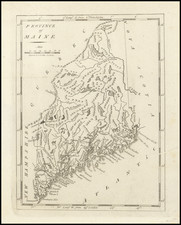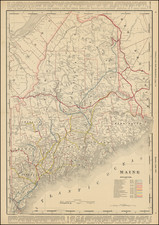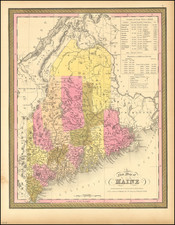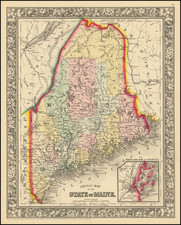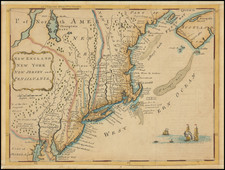Bangor & Aroostook Railroad and Connections, produced by the Rand Avery Supply Company of Boston around 1915, is an illuminating depiction of the rail routes and interconnections in Maine, extending from Belfast to the Canadian border. This map charts the Bangor and Aroostook Railroad's journey through various cities, towns, and villages, including the historical Katahdin Iron Works. It also showcases other vital rail connections of that era, such as the Maine Central Railroad, the Canadian Pacific Railroad, and the significant presence of the Canadian Government Railway along Maine's northern and eastern frontiers.
The early 20th century was a time of burgeoning rail networks in the United States, with the northeastern state of Maine emerging as a strategic hub for transporting goods, including the region's famed potatoes, and connecting to Canadian rail systems. The Bangor and Aroostook Railroad, originating from the merger of two other significant rail entities, epitomized this growth. The railroad's expansion throughout the initial decades of the 20th century reflected the economic and infrastructural developments of the period, eventually culminating in its pivotal connection with the Canadian Government Railways in 1915.
The map's features are not just limited to rail connections; it also highlights various lakes, including Moosehead Lake, emblematic of the Northern Maine hunting and fishing region. An inset map underscores the connectivity between Boston and Bangor, hinting at the broader geographical significance of this rail network. Moreover, the red route emphasizing the Bangor and Aroostook Railroad's path signifies its preeminence and offers a visual guide to its vast expanse.
The Bangor and Aroostook Railroad's history is one of innovation and resilience. Its endeavor to use heated box cars in the late 19th century for transporting potatoes underscores its adaptability and its pivotal role in the economic landscape of Maine. Despite challenges in the mid-20th century, which shifted its potato transportation dynamics, the railroad continued to serve as an essential conduit for various commodities, from chemicals for paper mills to ammunition during World War II. Its passenger services, epitomized by the Potatoland and the Aroostook Flyer, speak to its broader societal impact, ensuring connectivity for the inhabitants of Maine.









![[ The Finest Colonial New England Sea Chart of the 18th Century ] The Coast of New England](https://storage.googleapis.com/raremaps/img/small/63672.jpg)
